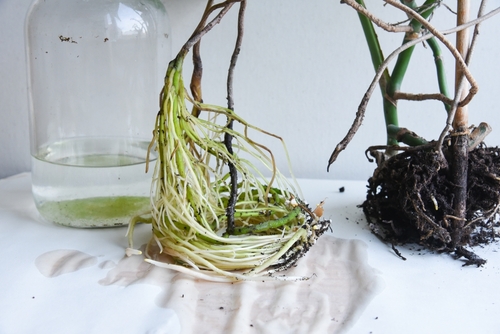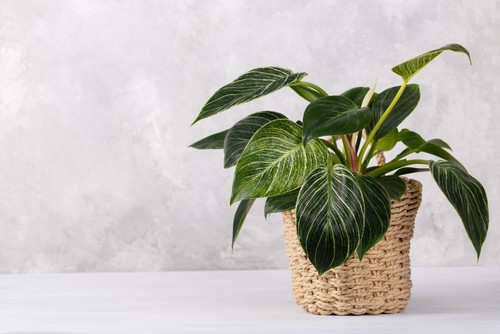As with other philodendron species, the Philodendron Birkins are easy to care for and have a stunning appearance. They are the type of plants that will always stand out among several other plants in your garden. But the Philodendron Birkin is not free from problems, such as brown spots appearing on its leaves.
All plants, including the philodendrons, are not immune to certain issues. One way to prevent brown spots on Philodendron Birkin leaves is to maintain a consistent watering schedule and avoid letting the soil dry out completely between waterings. Even when you are tending to your plant correctly, it may experience leaf discoloration. So what causes Philodendron Birkin Brown Spots?
Philodendron Birkin Brown Spots

Several factors can cause brown spots on your philodendron Birkin. But the most common ones are fungal infections from excessive watering or insect infestations. Other causes include excess fertilizer use, root rot, under-watering, and overexposure to light.
Fortunately, it is possible to get rid of brown patches on your philodendron plant. However, it would be best to identify the main cause of the problem so that resolving it will be easy and fast.
In this article, we will explain the possible causes of browning in your Philodendron Birkin and the solutions to it.
Now, let’s get started!
6 Possible Causes Of Philodendron Birkin Brown Spots
1. Over-watering
Generally, philodendrons prefer a moderate amount of moisture to stay healthy. However, allow the soil to dry out before watering it again. Not doing this will cause water to block the air passages between the soil particles.
As a result, there will be no oxygen supply for the philodendron, which can cause it to drown. This is one of the most common reasons your philodendron Birkin leaves have brown spots.
Dip your finger or a stick into the soil to check if there’s still moisture in it before watering it. While overwatering your philodendron Birkin is not ideal, under-watering the plant is similarly dangerous.
Solutions:
- Use well-draining soil for the Philodendron Birkin.
- During winter, reduce the number of times you water the plant. Watering it every 10 to 12 days is a good idea.
- Don’t use a hose to water the plant, as it can cause a problem of excess watering.
- While watering, make sure the water enters the soil deeply, not just the surface of the plant.
- Don’t water your Philodendron Birkin with tap water as it contains large amounts of chlorine that may cause harm to it.
2. Under-watering

Philodendrons grow well when you water their soil moderately. If your plant is not getting enough water, it will become dehydrated within a short time. Signs of a Philodendron Birkin that lacks moisture include dry leaves, drooping, and brown edges on leaves.
Solutions:
- Start watering the philodendron Birkin slowly, at least once every week.
- If you live in a hot or dry environment, water your philodendron Birkin at least 2 to 3 times a week.
3. Excess Fertilizer Use
Of course, applying fertilizer to your Philodendron is one of the ways to improve its growth. But when you add excess fertilizer to the soil, it will harm the plant’s roots. This is possibly why your Philodendron’s beautiful leaves have brown patches.
Other signs of excess fertilizer use include yellow leaves and the plant becoming droopy.
Solutions:
- Cut off the brown leaves from the Philodendron.
- Replace liquid fertilizers with slow-releasing pellets.
- Discard about 1 to 2 inches of the soil surface and add new soil to the plant.
- Water the plant thoroughly to wash off fertilizer residue on the soil.
4. Pest Infestation

Even though it is uncommon for pests to attack philodendrons, it happens sometimes, which causes brown patches on their leaves.
Pests that infest the Philodendron Birkin include aphids, spider mites, mealybugs, and scales. Once these pests attack your plant, it only takes a short time before its leaves begin to turn brown and become dry.
Solutions:
- Apply Neem oil or insecticides to the affected plant to get rid of these pests.
- Cut off the affected parts of the leaves to protect the healthy parts of the plant.
- Always check your philodendron regularly for signs of pests and manually remove them with a damp cloth.
- Spray the leaves with a moderate amount of water to wash off mites.
5. Exposure To Direct Sunlight
Generally, light plays an important role in the growth of plants. While the Philodendron Birkin needs light, they need just a little of it. If you expose the plant to direct sunlight, its green leaves may change to brown as a result of sunburn.
On the other hand, if the plant doesn’t get enough light, its leaves will begin to fade. This suggests that your Philodendron Birkin will flourish indoors as it doesn’t like full light or too little light.
Solutions:
- Place the plant in a place where it can get bright, indirect sunlight for at least 12 hours every day.
- Use artificial lighting if the plant is in a dark environment.
- Constantly rotate the philodendron Birkin to allow even development since the plant loves to grow towards the light source.
6. Root Rot

Another common reason there are brown spots on your philodendron Birkin is root rot. Usually, this problem happens as a result of using large pots, poorly draining soil, or overwatering the plant, which all cause excess soil moisture.
Apart from the browning of leaves, other signs of root decay include wilted leaves and poor plant growth.
One simple way to identify root rot in your philodendron is that its roots will be squishy and may turn black or white.
Solutions:
- Remove the philodendron from its pot and wash off the roots thoroughly, preferably under running water.
- Replace the soil with a fresh one.
- Prune all the affected parts of the roots and surrounding leaves.
- Replant the healthy part of the Philodendron Birkin.
More on philodendrons: Why Is My Philodendron Drooping
Final Thoughts
Now that you know the possible causes of brown spots on your philodendron Birkin and solutions, it’s time to act. Generally, philodendrons are easy to care for when you provide them with the right amount of water, light, and nutrients.
If you’re always busy, create a schedule for tending to these plants every week. And if you notice anything unusual in your philodendron, find out the main cause and solutions to it. This is a sure way to keep your philodendron Birkin happy and beautiful for a long time.
Frequently Asked Questions
How Do You Treat Leaf Spots On Philodendron?
For a start, make sure the base of your pot has good drainage holes. One of the major causes of leaf spots on philodendrons is inappropriate watering, which can result in leaf spot diseases.
Always remember to pour out any excess water residue in the pot. Most of the time, too much water in your philodendron’s soil exposes it to root rot and leaf spot diseases.
How Often Should You Water A Philodendron Birkin?
Water your philodendron Birkin only once a week, especially in spring and summer. But during winter, make sure the soil dries out before watering it again.
Even though your plant needs to be in a moist environment, don’t allow the soil to become saturated with water. Hence, it is important to use well-draining and well-aerated soil that will absorb water perfectly.
When Should You Repot A Birkin?
Ideally, you should repot your Philodendron Birkin at least once every two years. However, it is best to wait until you notice signs of stunted growth or leaf discoloration.
Slow or stunted growth may indicate that your philodendron’s pot is no longer able to accommodate the roots. So it is better to change the pot to a slightly larger one to allow the healthy growth of your philodendron Birkin.

Hey, I’m Lisa and I’ve been an avid gardener for over 30 years. I love writing, talking and living in the garden! Feel free to connect with me on my socials below

